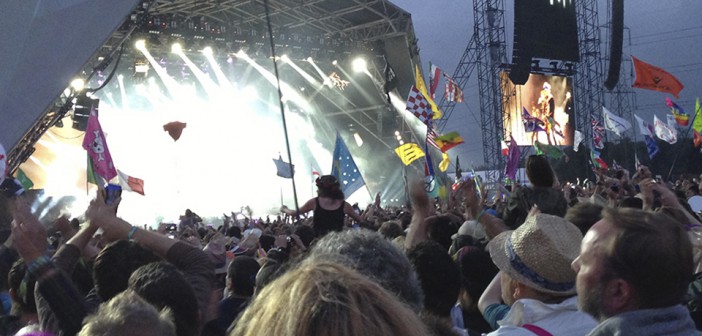Even if Team GB’s athletes had flopped at London 2012, a safe bet for things going right for Lord Coe was at the Opening and Closing ceremonies where the best of the British music industry would be able to strut its stuff; and show billions of onlookers around the globe, that we may have lost our colonial trading pre-eminence, but when it comes to music, we still rule the airwaves.
The Americans introduced us to Elvis, Michael Jackson, Nirvanna and Mr and Mrs Carter. Impressive. (Bryan Adams was Canadian) But let’s face it, our musical factory line… The Rolling Stones, The Beatles, David Bowie, Adele is right up there. If you looked at the downloads of British artists internationally and then created an algorithm that factors in the population of our island compared with artists from other countries, I strongly predict we would be sitting pretty on top of the musical world. But none of us have got time for that.
I did, however, have the time this weekend to visit Glastonbury – the king of all festivals and more proof that we do music better than anyone else.
Since we started our Future of Britain research, I have been looking at life a little differently – more tuned in than before to changing behaviour as economic austerity and technological revolution collide. And what struck me during my time down at the Worthy Farm was how much of a reflection of modern British cultural life Glastonbury provides – and how it showcases many of the contradictions we are seeing shape the future of Britain.
There were some obvious ones for all to see, such as everyone’s pre-occupation with digitally capturing moments of social kudos and sharing via mobile phone with friends. I was particularly guilty of the Glastonbury gloating, in a thinly veiled attempt to show my friends I’ve still got it. But what else did I see through my Future of Britain sunnies?
First up, it struck me on my first ever visit to Glastonbury, how even this festival – held up as the least corporate and brand averse of them all – reflected the growing demand and craving in Britain for VIP status.
I was a very lucky boy at Glasto. I stayed in what’s known as a Yurt. In fact one of a number of yurts – an avenue of Yurts, collectively known as a Yurtel. Some call it Glamping – the coming together of Glamour and camping. I think of it as Champing. Prosecco provided on arrival. Shower towels and eye mask in the welcome pack. Double bed with cotton sheets. Eggs benedict served in the morning. Regular Glasto folk may stop reading at this point, I apologise. As our driver ferried us in to the festival by golf buggy down past the favella-like camp-sites, it struck me how seasoned Glastonbury goers would have turned in their sleeping bags at the thought of me rocking up freshly showered and full of sour dough toast. But this is life in Britain today. From speedy boarding to fast-track check-outs to VIP phone packages with extra incentives we seek out ways of securing an elevated experience and status that sits somewhere above what the rest get. And if brands can provide that VIP status for their customers it is a route to loyalty, advocacy and just maybe, love.
My second observation was clear evidence of the closing age gap that is disrupting traditional demographics. Dizzie Rascal went bonkers in front of a crowd with an age profile that swung from 7 to 70. A packed house waved their hands in the air like they didn’t care to 70’s disco legends Chic, with half of the crowd not having been born when Nile Rogers and his crew were top tenning. Glasto’s headliners this year were a group of rockers in their 70’s and the sleepy finale to the festival on its main stage was given up to folk band – Mumford and Sons. Glastonbury is the coming together of people from all walks of life, not defined by age or origin, but sharing attitudes and interests. And back to the bricks and mortar world, as multi-generational households grow in numbers, as fully educated children boomerang back to living with their parents, as the retired generations relive their youth, we have to increasingly look at audiences through the Glastonbury goggles, where it is insights around attitude which matter most.
And third and finally, the sovereignty of the consumer in dictating what is and isn’t acceptable in the behaviour of brands. Glastonbury prides itself as being a brand-free zone – excluding the presence of multiple charitable organisations of course. And yet if brands can find a way of providing usefulness, then people will not only be accepting, they will swing fully to advocacy. At Glastonbury, everyone is walking around with the Guardian’s miniature festival guide around their neck and there was much talk of Everything Everywhere’s clever Festival app –along with their well-used recharge tent, enabling people to maintain their Glastonbury gloating all weekend. So even in the most anti-brand of environments, those two got it right simply by identifying what people need, and providing it.
The trick of it all is to stay close to what people need. Our Future of Britain study aims to ensure we help our clients with that. Back at Glastonbury, on that basis, I’d suggest Dove or Persil could have done some sampling at the exit gates on Sunday night, although this wouldn’t be necessary for people leaving their Yurts!





1 Comment
Pingback: The Future Of Britain“I was there!”…virtually | The Future Of Britain